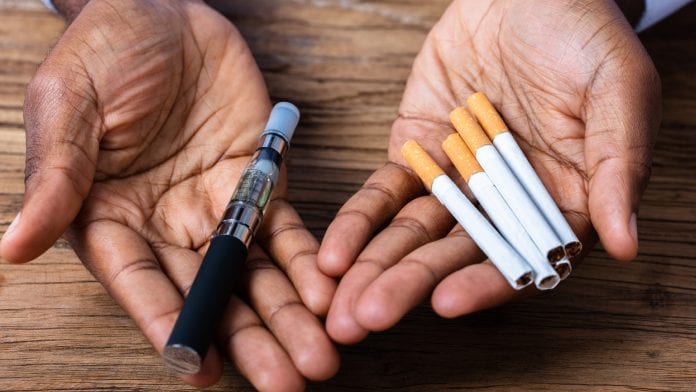
A comprehensive review of the respiratory effects of vaping has highlighted its adverse biological effects on cells in humans and animals.
Four scientists from four leading universities in the United States conducted a comprehensive review of all e-cigarette, or “vaping”, peer-reviewed scientific papers that pertain to the lungs and published their findings in the British Medical Journal.
The team of four authors strongly recommend tighter regulation of e-cigarette products.
Effects of e-cigarettes on lung health
Corresponding author Rob Tarran, PhD, professor of cell biology and physiology and member of the UNC Marsico Lung Institute, said: “Studies show measurable adverse biologic effects on lung health and cells in humans, in animals, and in tissue samples studied in the lab.
“The effects of e-cigarettes have similarities to those seen in traditional cigarettes and important differences.”
Doctors know that the development of chronic, life-threatening diseases related to cigarette smoking, such as lung cancer and emphysema, take decades to develop. Also, it took decades to scientifically prove that smoking cigarettes caused cancer.
Vaping has been popular for about 10 years; however, scientists have only been studying the effects of e-cigarettes for about five years. What they have found so far suggests that vaping is not without effects. It is not “safe”.
Tarran, who is also a member of the UNC Lineberger Comprehensive Cancer Center, said: “The scientific community’s current knowledge is insufficient to determine whether the respiratory health effects of e-cigarettes are less than the now obvious health effects of combustible tobacco products.”
Key findings
A number of epidemiological studies have shown increased respiratory symptoms in adolescent vapers, such as increased bronchitis-like symptoms, increased asthma, shortness of breath and more.
The researchers found a number of studies that showed effects of vaping on the whole lung, including possible lung damage (such as damage to the lung’s blood supply), and identified case reports from around the world indicating lipoid pneumonia, that is similar to what is seen with the current epidemic in the United States.
The researchers reported on a number of animal studies which typically found increased risk of lung damage and immunosuppression, such as increased susceptibility to bacterial or viral infections.
Tarran said: “We also evaluated the effects of vaping on cells in the laboratory (in vitro studies).
“Most studies found that e-liquid exposure to pulmonary cells had effects including general cytotoxicity and impaired specialised functions, such as secretion and phagocytosis, which are important for proper lung function.”
The researchers reviewed the possible health effects of e-liquid constituents including nicotine, propylene glycol/vegetable glycerine, and flavours. All have been shown to have adverse effects in animal and lab-based studies at some concentrations. However, given the range of vaping behaviours in the real world, it is impossible to know the exact concentrations vapers are exposed to over any given timeframe.
Tarran said: “Interestingly, when we looked at all the published papers on primary pulmonary cells – straight from the lungs of people to the lab – the only reports that did not see an effect of vaping on these cells were studies funded by the tobacco industry.”
Regulation recommendation
The researchers also provided recommendations for clinicians and for future regulation of e-cigarettes. For heavy smokers, e-cigarettes should be prescribed cautiously as a smoking alternative, and should only be recommended as a cessation devise along with counselling and other therapies to help quit nicotine-product use permanently.
Tarran said: “We recommend that vape products be regulated more stringently along the lines of pharmaceutical products that go through a well-defined series of pre-clinical and human studies before they are released on the market.”
The researchers also highlighted the challenges facing researchers in the field and provided recommendations for future research, such as the need to research the potential detrimental effects of vaping on adolescent lung development.
























